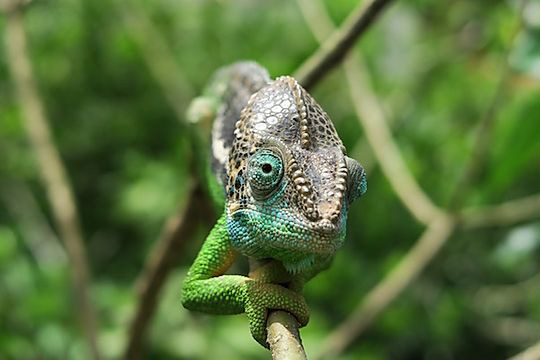Madagascar Trip Report
Reported by Brooke Berlin
Text and photographs are provided through the courtesy of Johann Van Zyl and Brooke Berlin.
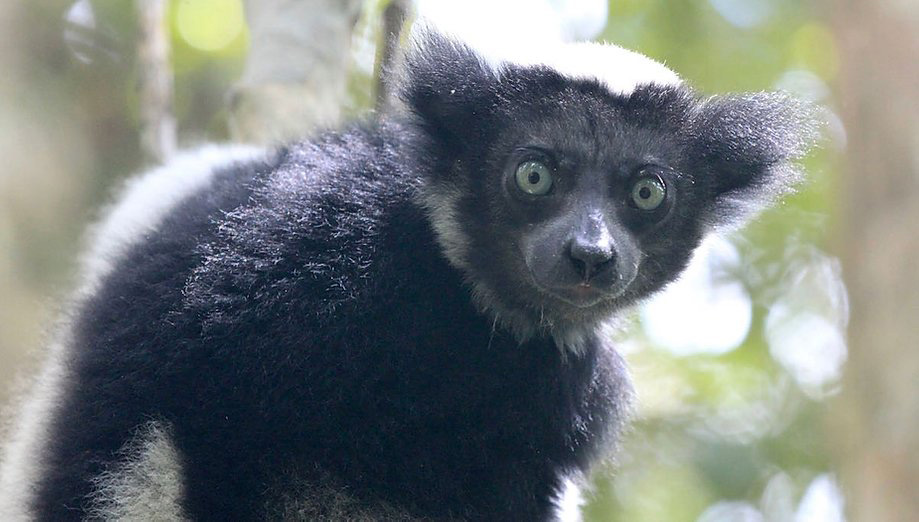
Arriving in Madagascar:
Day 1: Antananarivo (“Tana”)
Antananarivo – City of a Thousand – is a wonder to behold. Located 4000 feet above sea level, it was the coolest and most arid location we encountered during our December travels (though that’s not saying much). While there are modern hotels very near to the airport, we chose to stay in the quaint historical city center about 15km away. In rare moments of little traffic, the journey takes about 30 minutes; more often it takes more than an hour. But it’s worth it!
Eperlan, a Mada Classic agent and our host for the day, picked us up with Antsa, our driver. We exchanged money right at the airport (the exchange rates are more expensive in Tana), and made our way to Pavillon de l’Emyrne, a classic French mansion-cum-inn that would be our home base in Tana. Eperlan has been with Mada Classic for two years; before he was a volunteer coordinator for Habitat for Humanity so has hosted many Americans and knows the country exceptionally well. He teaches me the three words I’ll use most in the next week: salama – hello, veloma – goodbye, and misaotra – thank you.
The drive is a progressive time machine, starting with the ultra-modern U.S. Embassy, typical African rugby and football fields, roadside markets, sprawling rice patties. Once in the city we pass by Citron and Renault cars converted into local taxis, men walking with cages of Kuba Bread to sell (Malagasy rice bread with banana and peanuts), a lake with a monument in the middle honoring the Malagasy soldiers who died fighting for France in WWII.
Pavillon de l’Emyrne is charming! Everyone who works there is wonderful, but I’m most partial to Bakoly, the complimentary masseuse I schedule for a traditional Malagasy massage each time we arrive. We have to overnight in Tana every time we move from one part of the country to another because of the random changes and cancellations of Air Madagascar flights. Pavillon de l’Emyrne is the perfect place to have as a home base.
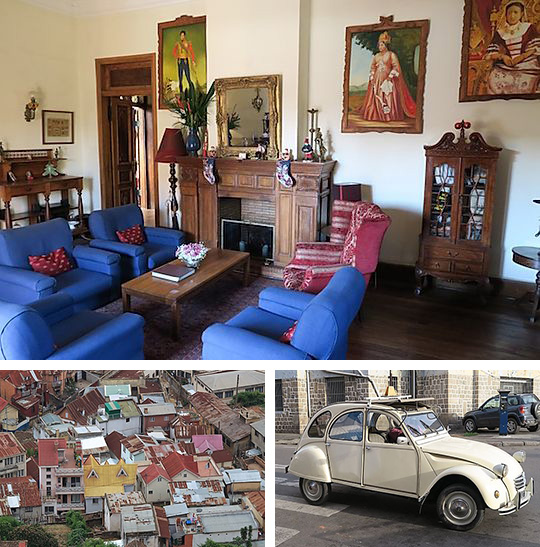
A Week in the South:
Day 2: Tana - Fort Dauphin - Mandrare River Camp
Our first experience with Air Madagascar was near flawless as it only left half an hour late. That said, you must be at the airport two hours prior to any flight, and so we left Pavillon de l’Emyrne after breakfast for the hour drive back to the airport where we settled in with our audio books and travel guides. The flight was an hour to Morondava where we exchanged passengers, and another hour-and-a-half to Fort Dauphin (Tolanaro) where Andreas, our guide, greeted us with Erik, our expert driver. The drive is at least three hours over pot holes the size of sinkholes (we hear the EU is planning to build a new road – for better access to a coal mine – that will improve most of the drive and lesson the time). At Mandrare Rive Camp two other American couples, both of which are in their mid-to-late 60s, accompany us. One couple chartered a flight (200 euro per person each way) from Fort Dauphin to Mandrare that takes only 45 minutes and lands three minutes’ drive from Camp.
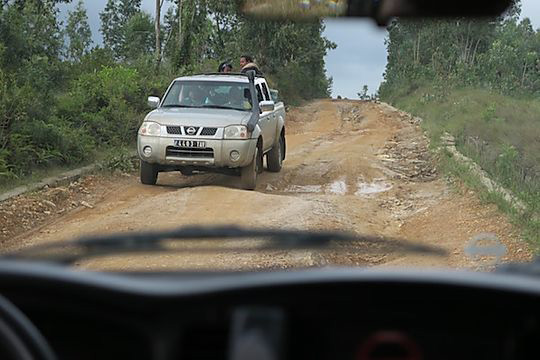
During our drive we passed over the Ifaho River, saw giant elephant ear plants in the greenest rice fields, endless eucalyptus trees (a non-native species), and engaging smiling faces. We stopped at a street to buy a basket of lychee for 5000Ar (about $1.50), which apparently included the basket! We slowed for men moving their Zebu (cattle) to market. And stopped to learn about the three ecosystems of Andohahela National Park, the 72,020-hectare park created in 1936: spiny forest (west), transition forest with the rare triangle palms, and rain forest (east). Then came the sprawling sisal plantations, and finally the Mandrare River!

Day 3: Mandrare River Camp
Mandrare River Camp exceeded every expectation! We were impressed day after day with the delicious and beautifully plated food – bravo chef! The cultural activities set up for us were fun and so unique. Our guide Andres was a book of knowledge (speaking of books, pick up Alison Jolly’s “Lords and Lemurs” and pay attention to where Andreas is quoted!) paired with a beaming smile and easy laughter. And Jacques was manager and host extraordinaire (originally from South Africa, he has worked in the safari industry there and brings a level of sophistication to Mandrare River Camp that you would expect in Southern or Eastern Africa). Truly every detail was anticipated and executed to perfection. Oh, and of course the lemur sightings (and other interesting creatures) were out of this world!!
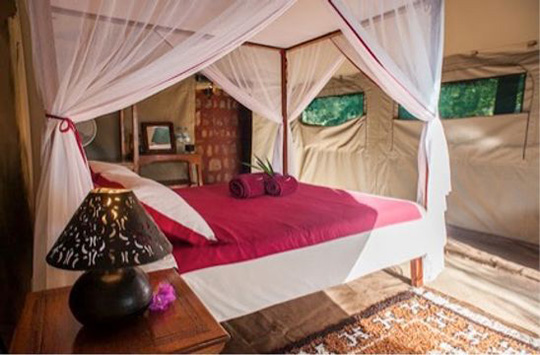
Our first morning we explored the Ifotaka North Protected Area’s Spiny Forest, which is a community protected area established in 2006. There are 700 endemic Euphorbia in Madagascar, and my favorite quickly became the octopus tree that helped create the amazing texture of the spiny forest. On this early morning, pre-breakfast walk we saw three different troops of Verreaux’s sifaka lemurs. The first troop of three included a several-month-old baby, and so we learned that in general, most sifaka have their babes in August. The second troop was seven strong, also with a few babes, and the third troop went back to three. These large white creatures with brownish crowns and black faces cooed softly to one another as they cleaned themselves, fed on the trees, and jumped sideways along the ground. The spiny forest is known for four types of lemur - Verreaux’s sifaka, mouse, sportive and ring-tailed – we would see them all, in addition to things like the rare hinge tortoise, intriguing Napoleon’s hat tree, and myriad birds including the grey parrot, most of which I believe were Andreas’ way of distracting me from seeing snakes. It is this same forest that we would return to later on for our night walk, where, to the sound of cicadas, we would don headlamps and spot chameleons, owls, nocturnal lemurs and more.

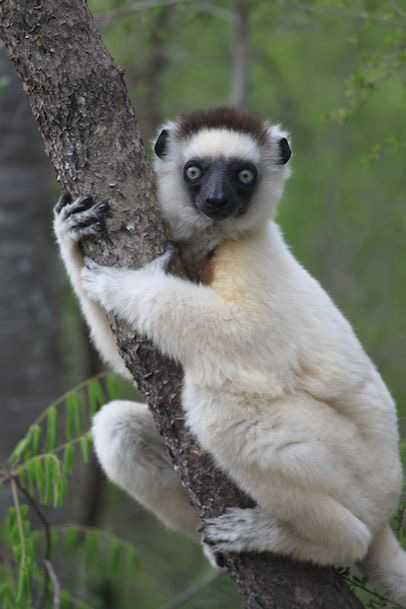
After breakfast we wandered through the Thursday Market. The Antandroy people of this region travel hours and even days to fill this vast and colorful market with clothes, housewares, fruit and veg, livestock, electronics, and anything else you might need for daily life here. We walked out of the market and through the Ifotaka village to see daily life in action, and among all of the social gatherings, the one I loved the most was the women sitting together meticulously braiding each other’s hair into stunning designs, each one with a specific meaning of course. In keeping with this cultural immersion, that afternoon we crossed the Mandrare River to visit the Sacred Forest, which is filled with the ancestral tombs of the Antandroy Tribe.
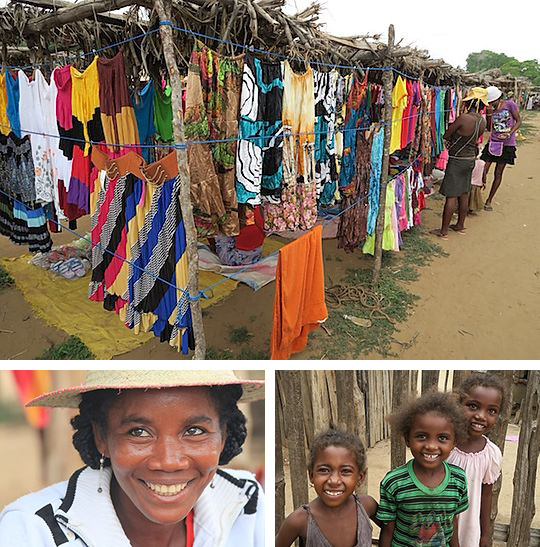
Day 4: Mandrare River Camp
This morning we entered the Ifotaka North Protected Area’s Gallery Forest. After a short drive south along the sisal fields, we were ferried across the Mandrare River again, this time to the gallery forest, also known as the riverine forest or canopy forest. This beautiful forest of mostly tamarind is home to large groups of ring-tailed lemurs, and no more than five minutes in we encountered our first troop of seven of them, playing, grooming, and scent marking. Our second troop included at least 15, with lots of little babies. We sat with this troop for nearly half an hour and eventually, in our stillness in the center of a grove of trees, it felt like we had become one with their family as they surrounded us but paid no real attention to us. We saw other unique things in this forest such as ghostly white Banyon trees and electric pink flatid leaf bugs; and of course, more Verreaux’s sifaka.
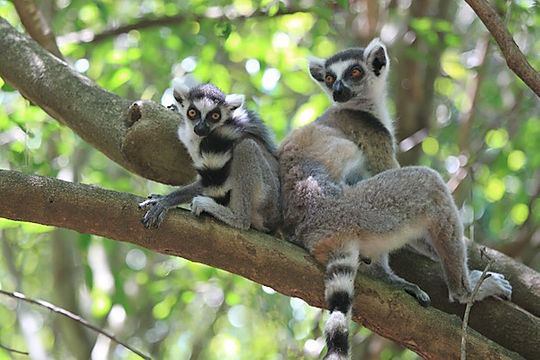
After lunch we returned to the site of the market, but the stalls had been packed away and the space converted into a sport field. A traditional Malagasy wrestling tournament called a ringa was taking place. Men proved their power by toppling their opponent, while women sang songs of encouragement and danced around them.
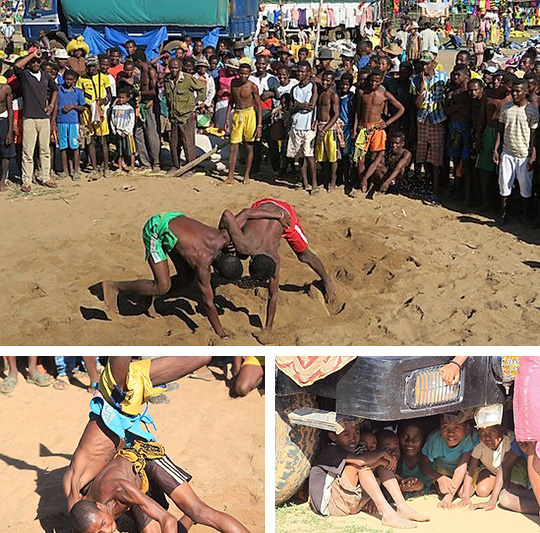
Our last evening was marked with sundowners among the baobabs, with views across the sisal fields to the mountains beyond. Before dinner we were treated to a cultural performance of traditional music and dance.
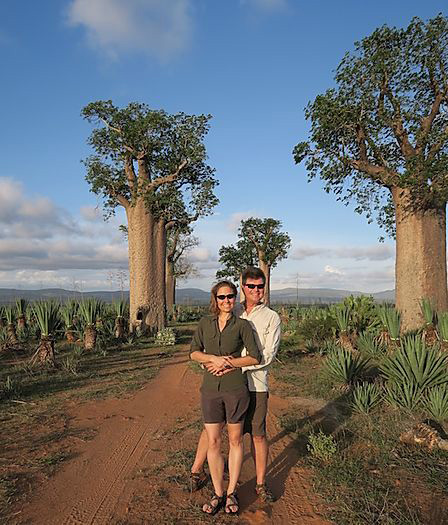
Day 5: Mandrare River Camp – Fort Dauphin – Manafiafy Beach Lodge
We collected ourselves for the drive back to Fort Dauphin, where we stopped for a delicious lunch overlooking the Indian Ocean, and an Internet fix. Erik stayed on as our driver for the journey to Manafiafy, and we were accompanied by Manafiafy’s manager magnifiqué, Elené, who ran a restaurant in Fort Dauphin for years after moving to Madagascar from South Africa. Elené narrated the two-hour drive to Manafiafy, also known as Sainte Luce, with a bit of history, a modern take on the area, and information on the interesting things we would have missed: ancient tombs, red pineapples, and carnivorous pitcher plants. We stopped en route to see the Madagascar flying fox (bats with a wingspan of 1.2m that are known to form colonies of up to 5,000), though because of the rain our sighting was far fewer than the thousands that make them so popular.

Manafiafy Beach Lodge has a pristine location on a stunning stretch of white sand on a beautiful bay, fringed with forest-covered mountains and wildlife-rich mangroves. It offers exceptional food (they do gourmet on a five-star level, but our favorite dish was the local ravi tutu:zebu and cassava leaves over rice with sakai, mashed up chilies), near-luxury accommodations, and lots of fun! Our guide, Ernest, who is of the Antankarana Tribe of Diego Suarez, has been at Manafiafy for five years.

Day 6: Manafiafy Beach Lodge
Ramaniry, our boat captain, Thomas, our skipper, and Ernest were waiting for us this morning for our light sport fishing excursion. Our first stop was to get bait from the local fisherman already on the water but closer to shore, and then we headed into the Indian Ocean to reel in giant chevalie, king fish, wahoo – the tuna got away. There were times we were fishing alongside the locals who of course know the best spots for active schools; times we were on our own with dolphin pods playing around us; and one time we were asked to assist a pirogue with three men who had been working their line for an hour and needed backup. It was a fun day on the water, though I think it must be magical to see when the fishermen go out at night with torches and it looks like the stars fell from the sky. Johann caught a record 22 fish, which made everyone ecstatic as we gave some to the men in the pirogue, some to Ramaniry and Thomas, and some to Manafiafy’s staff, only keeping the ones we were going to eat for lunch, which were served as sashimi, ceviche and a grilled filet.


After lunch we visited Stitch, a community project associated with the NGO Azafady that teaches women needlework and provides a space for them to both work and learn English.
That evening started with a spectacular sunset. We sat on top of the rock cliff at the end of the property (quite close to the massage pavilion we enjoyed earlier in the day) and watched the concert of colors crescendo around us. Then, Elené hosted a Madagascar Rhum tasting comprised of two local Dzama Rhums, one local Mangourstan Rhum, and two of her homemade Rhum Arrangé (fruit and spices soaked in Rhum). I became a fan of Rhum drinks on the spot; Johann continued to enjoy Three Horses Beer (THB) and Gold – Extra Forte.
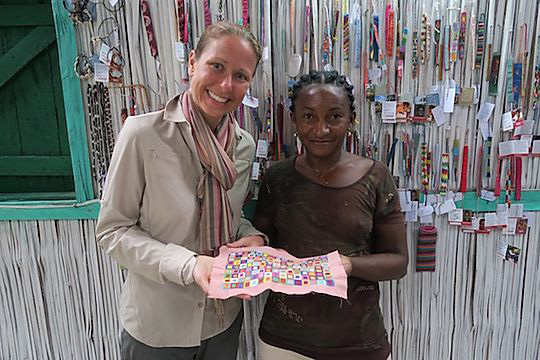
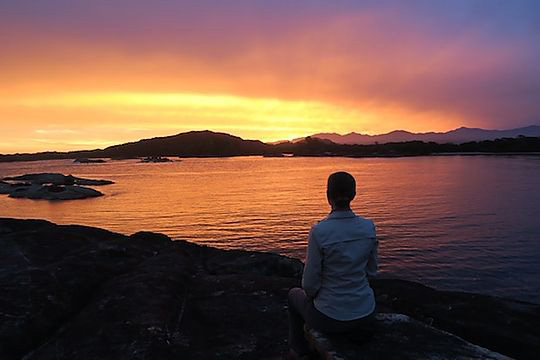
Day 7: Manafiafy Beach Lodge
Ernest introduced us to Rasulu, the man from the community who looks after the forests by accompanying groups, as we started our morning walk in the S9 Forest. This protected forest is about 500 acres and starts with a flat, soft, sandy trail that leads into beautiful thick bush. The smaller of our sightings included the Stick Insect and Green Day Gecko; lemur sightings here included the Southern Wooly Lemur and Red Colored Brown Lemurs; and we also saw some lovely, delicate orchids in bloom, which was so nice as October is the typical time for orchid flower viewing. After our forest walk we meandered through the Manafiafy village to the beach where fisherman keep their boats and sell their days’ catch before heading back onto the water ourselves.
A different boat brought us to one of the two nearby islands where you can snorkel, explore, and in our case, enjoy a private picnic lunch – complete with fresh uni (sea urchin) taken from the ocean that morning and prepared on the spot. Upon return, from the water you can see Manafiafy’s 15-foot-high whale watching observation tower, which comes in to play mostly June through November. Before entering the bay, we veered off into the mangroves, which come alive in the morning when the birds are most active and you can kayak along the tranquil shores.
Day 8: Manafiafy Beach Lodge – Fort Dauphin – Tana
The day before our departure, our flight from the south was changed from noon to 8am, so we had to get up at 3am for the three-hour drive back to Fort Dauphin to check in two-hours in advance, a necessary timeframe so Air Madagascar doesn’t re-sell your ticket and bump you. Insane. Needless to say, it was an exhausting day. I was happy to reach Pavillon de l’Emyrne, nap, check email, get a massage, enjoy a relaxing dinner, and drift off to sleep.

A Week in the North:
Day 9: Tana – Diego Suarez (Antsiranana)
Our flight to Diego Suarez took off as scheduled and the three-hour flight provided a nice scenic tour of the northeast coast, including a quick touchdown in Sambava. Before leaving the harbor town for Nature Lodge, our more mountainous retreat in Joffreville, we asked our guide, Simon, and driver, Jacques, to take us around to get an idea of the area. Simon has been with Mada Classic for seven years, and lives in Joffreville, so he knows the history here well. Diego is the most prosperous, well-off city in Madagascar, mostly due to the prominent harbor leading to the Indian Ocean and the growth of tourism. It’s actually the world’s second largest bay, after Rio de Janeiro, at approximately 100 miles around.
When we drove by the port there was a UN ship at dock. The strong economy of Diego comes from tourism, a large-scale canned tuna factory located at the port, numerous cash crops (ylang ylang, coffee, cocoa, etc.), and rich cultivable land that locals use for themselves (rice, maize, cassava, etc.). This also leads to much better roads than we experienced in the far south. Bright yellow Tuk Tuks zoom around town, and in this mostly Muslim area we start to see brightly painted Mosques. At the far end of the posh Avenue Colbert is a well-kept French colonial era mansion that allows us to imagine what many of the other buildings ruined in the most recent cyclone would have looked like in their prime (cyclones tend to wreck havoc on Madagascar every January through March).
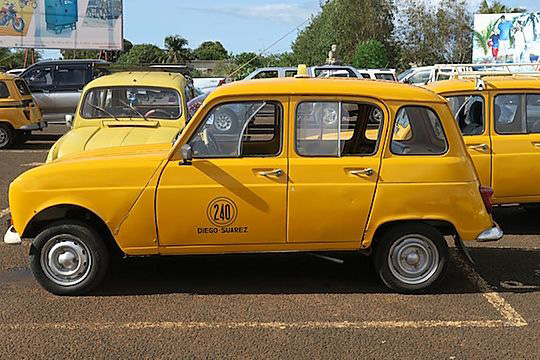

Day 10: Amber Mountain National Park
It takes about 20 minutes to drive from Nature Lodge, through Joffreville, to Amber Mountain National Park. Established by the French in 1958, this volcanic massif and its surrounding forests are now one of the country’s best examples of ecotourism. Here, thousands of acres of mountain rainforest are home to extraordinary plant and animal life. More than 80 percent of Madagascar’s rare and fascinating flora and fauna exist only on the island, and Amber Mountain let’s you tick off endemic species (specific to Madagascar) after endemic species (specific to Amber Mountain): leaf tail gecko, Harold Mayer lizard, Madagascar magpie robin, etc. And the chameleons! There are only 120 species in the world, 70 of which are in Madagascar, 11 of which are in Amber Mountain. We saw the elephant ear chameleon, blue nose chameleon, and Amber Mountain stump tailed chameleon (smallest in the world) among others. Oh and lemurs … we ticked two more: Sanford’s brown lemur and the crowned lemur. Are you a twitcher? We saw Madagascar’s most colorful bird - the ground roller – along with the Pigmy King fisher, weavers and more. It was a great morning, paired with an afternoon of leisure, tucked into a comfortable open-air pavilion at the lodge, reading books as the rain fell.

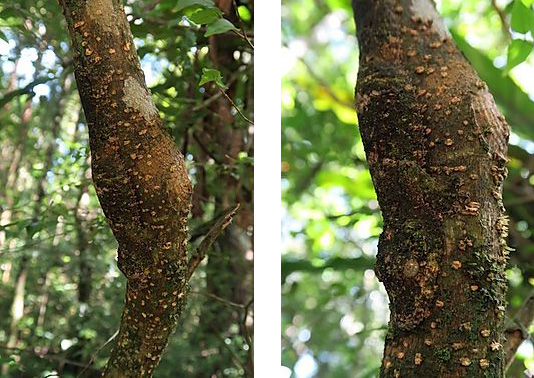
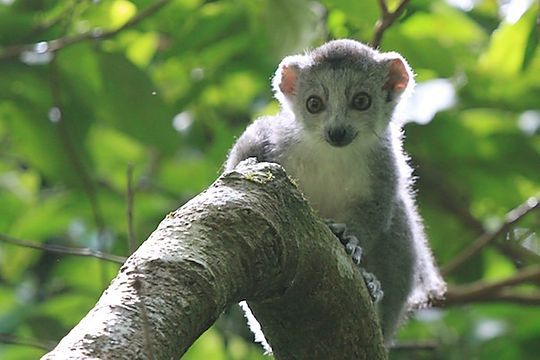
Day 11: Amber Mountain - Ankarana
Before our three-hour drive to Ankarana Lodge we toured two other properties in Joffreville: The Litchi Tree Hotel (my #1 choice) and Le Domaine de Fontenay (Johann’s #1 choice).
Nature Lodge: The spacious 12 bungalows are arranged along the edge of the property, facing out to offer views toward the bay. They are comfortable and well kept up with hot water on demand, but electricity only available from 6-10pm. During those evening hours (slow and spotty) wireless Internet is available in the main lodge. The main lodge and open-air pavilion are in very good nick with lots of great seating arrangements, nice art, and beautiful evening lighting. The food was very good and the service excellent. Warm, simple hospitality that ensured we had everything we needed.
Litchi Tree: Owned and operated by a friendly French man that you want to have a drink and share stories with. The grounds are manicured to European formal garden standards and offer a view of the bay. He personally restored the villa and horse stables that were originally built in 1902. The décor is a combination of modern (red walls and mod furniture in the sitting room) and historical (antique photos, books and liquors). The bar is exceptionally well stocked.
Domaine de Fontenay: Owned and operated by Karl-Heinz Horner, a jovial German man who personally renovated the century-old manor house and horse stables into an award-wining hotel. There are eight expansive ensuite rooms and one master ensuite suite with private terrace (this is the only room with a view of the bay; all others are on the ground level facing the gardens). Each room has a built-in sound system, air-conditioning, and 24-hour electricity in each room; but no wireless Internet. Karl creates delicious meals that are served before a famous Fustave Eiffel chimney. The furniture and décor seemed a bit dated and worn. Domaine de Fontenay has a private 300-hectare nature park where Johann did a night walk when we first arrived. The nature park is open to the public, and most cruise ships that spend a day at Diego will have a shore excursion here. This is also the property National Geographic currently includes in its private jet world tour.
Ankarana Lodge: The three family bungalows and seven rooms are all ensuite, air-conditioned and offer 24-hour electricity; but no wireless Internet. They are arranged throughout the property on either side of the pool, bar and just built dining pavilion. The food was very nice, and the service was sweet and kind, which made up for a slight lack in refinement.

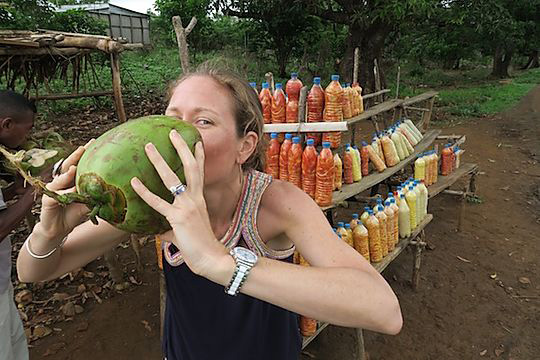
Day 12: Ankarana National Park
One word best describes this park – Tsingy! While you walk through dry deciduous forest spotting sportive and crowned lemurs, caterpillars as bright and yellow as the sun, forest crabs living in tree nooks, scorpions staked out under rocks, and learning about the more than 900 medicinal plants of Madagascar, the reason you come here is the Tsingy. The otherworldly landscape of eroded limestone is a majestic sight. Ankarana means place of the rock (An = place; Karana = rock), and these sharp, jagged rock formations create a unique labyrinth to explore. The forest path leads out to an expanse of Tsingy, where you step on top of the rock as a new path leads to a suspension bridge leading from one photo op spot to another. Right now, in December, the trees are full and green, but this deciduous forest acts as you would expect and in June and July you’ll see leaves changing color where as in September and October you’ll see colorful flowers in full bloom.

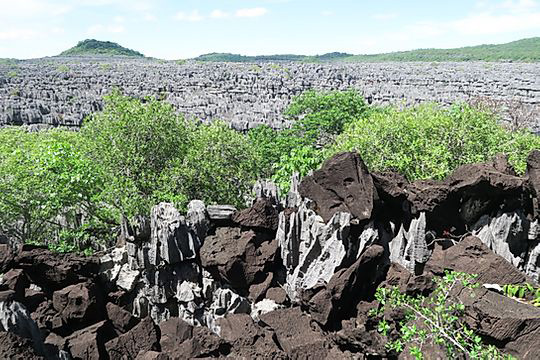
Day 13, 14, 15: Ankarana – Ankify – Nosy Be
From Ankarana we set out for the three-hour drive to Ankify Town, which is where all boats bound for Nosy Be leave from. Our pre-arranged, 40-minute, private speedboat charter to Nose Be was waiting for us, as was a driver for the 20-minute drive to Royal Beach.
At this point in the trip, we were ready for three days of lazy nothingness. We read “The History of Madagascar” and listened to audiobooks under a beach umbrella, at the bar, and from our air-conditioned balcony window. Daily massages were a given at USD$20 each. Room service brought Zebu burgers. One evening we ventured out for a stroll down the beach to the nearby town and saw that we could have explored more of the island on bicycles, ATVs, motorbikes; and then we strolled back and had another cocktail!
Royal Beach is a proper resort hotel with 42 rooms and 6 suites. The rooms are all en suite with a sea view balcony, air conditioning, TV (though the only English channel was the BBC world news), and wireless Internet. The gym area looked fully equipped, though we only walked through it to get to the spa. Beautiful pool, manicured gardens, plenty of chaises, cabanas, and tables. There is a more formal restaurant, a casual dining spot, and bar with live music. I’m sure there are more upscale resorts on more secluded parts of the island, but this one definitely lives up to expectations and we’d happily return.
Day 16: Nosy Be – Tana
Our direct flight from Nosy Be to Tana left an hour later than scheduled, at 7pm, but luckily Royal Beach was in the position to grant a late check out of 4pm, so we basically had another day to enjoy doing nothing. Back in Tana, Alan, our guide, has been with Mada Classic for years as well. He started as local guide at Andasibe in 1993 and overtime has built up so much knowledge and expertise that when we met him, he had just returned from Anjajavy where he was leading a guide training. He picked us up with Patrick, our driver, and brought us back to Pavillon de l’Emyrne for the night.
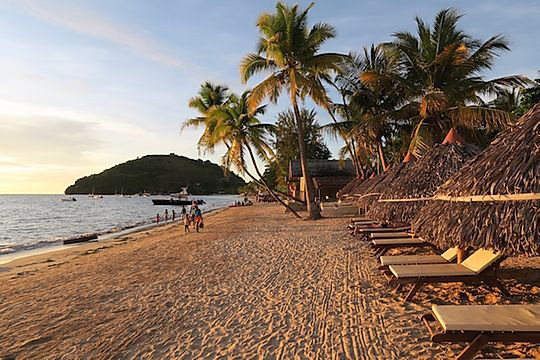
A Week in the East:
Day 17: Tana – Perinet/Andasibe
After breakfast we start the three-hour drive east to Perinet (Perinet is the French name for Andasibe). The road is well maintained as it is the main transport for goods from the port to Tana, but it is curvy! You’ll twist and turn for almost the entire drive through rural towns with red brick houses, rice fields tearing at the seams of the valley walls, and roadside stalls selling the seasonal harvest.
Vakona Forest Lodge: Named for the giant Pandanus plant, this lodge is true to its name. The main area is an octagonal building with a log fireplace at the center, and surrounding it is reception, the restaurant and bar, a game room, sitting nooks, and a curio shop. Windows along most walls give you a good glimpse of the natural surroundings, and one door leads out to a large deck where beyond you’ll find the pool and hamam, with a masseuse available for treatments. Walking trails connect the 24 bungalows and surrounding forest. In the cooler months guests stay warm with hot-water bottles in the beds.
We also toured Andasibe Hotel: This is the newest hotel in the area, and the most modern. It opened in 2010 and they have been expanding ever since. There are now 20 spacious bungalows, all en suite, with heaters in the rooms for cooler months. There is a small swimming pool and a masseuse available for treatments.
Exiting news is that Madagascar Classic Collection will soon open their third lodge in Madagascar here at Andasibe!

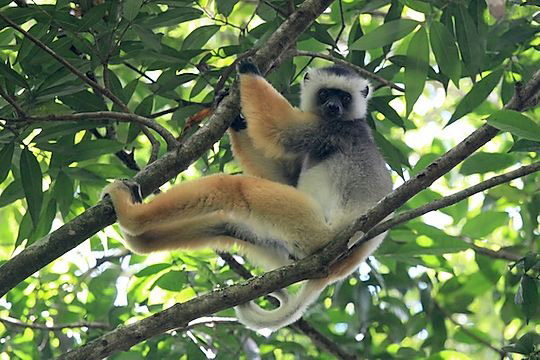

Day 18: Andasibe National Park
Also known as Perinet Reserve or Analamazaotra Reserve, this 810-hectare National Park is the last safe-haven for the largest of all lemurs, the Indri Indri. This adorable, black-and-white lemur has a barely there tail and a loud, eerily haunting call. Uniquely, they cannot survive in captivity, so it is crucial that its natural habitat is protected. There are another 11 species of lemurs that live in this area including the grey bamboo lemur, the common brown lemur, and diademed sifaka. Our Indri sighting was a family of three and we spent half an hour watching the seven-month-old perfect its jumping skills while mama and papa ate. The common brown lemur tends to live in groups of 10-25 individuals and our sighting of them confirmed that. The second-largest lemur, the diademed sifaka, is also a sight to behold, and we got to watch a troop of seven swinging in the trees and huddle together after a few alarm calls were made. The birds that left an impression here were the blue coua, paradise fly catcher and a crested ibis protecting its nest.
That afternoon, we visited the Lemur Islands, five small islands operated by Vakona Nature Lodge in order to provide a home for rescued lemurs that were once pets and transition lemurs born to them back into the wild. The manmade islands were constructed in 1996 and opened to visitors in 2000. Four guides and three other employees manage the Lemur Islands, now home to four types of lemur: grey bamboo, Rufus brown, black and white ruffed, and common brown. Buta, our guide, takes us onto the one island open to visitors, which has 27 habituated lemurs. In total, the four other islands are home to another 64 lemurs in the process of being reintroduced to the wild.

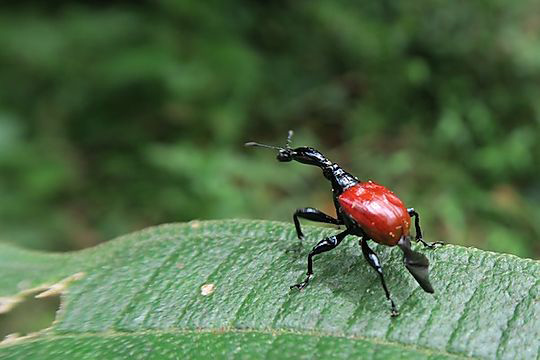
Day 19: Mantadia National Park
While the entrance sign is quite close to Vakona Nature Lodge, it is about an hour’s drive to access Mantadia National Park. This park is larger and has more varied altitude than Andasibe. Those two things, combined with it being a virtually untouched primary forest, results in some exceptional animal sightings and breathtaking scenery. Pictured is one of the smallest frogs in the world. Madagascar is so diverse that just this January two new frog species were discovered nearby!
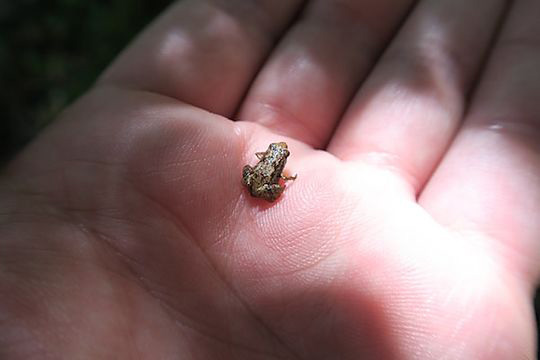
Day 20: Perinet – Tana
We got an early start after a quick, light breakfast for the drive back to Tana so that we could enjoy a nice leisurely lunch and an afternoon touring the city highlights.
Lokanga Boutique Hotel & Restaurant, owned and operated by Fabiola Deprez, offered a time-traveler’s respite for lunch. Situated on Royal Hill, the highest point in Tana, the expansive terrace where lunch is served offers spectacular views over the city. The lunch fare was simple and delicious, served with a chilled white wine, and afterward Fabiola offered us some of the Rhum Arrange from the assortment of antique glass bottles on a bar cart inside. This French/Malagasy home from the 1930s is quirky, posh and outfitted with modern amenities all at once. The six en suite rooms are uniquely and personally decorated with heirlooms from Fabiola’s family (four-poster beds, wardrobes, claw-foot bathtubs). And it is within walking distance of many of the historic sites in the area including the Queen’s Palace.
Day 21: Depart Tana
Johann is already planning his next trip to drive the RN7 from Toliara to Tana!

